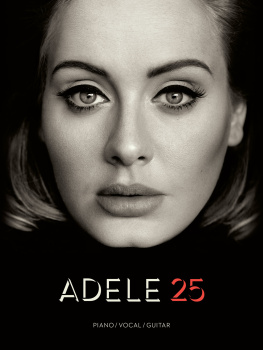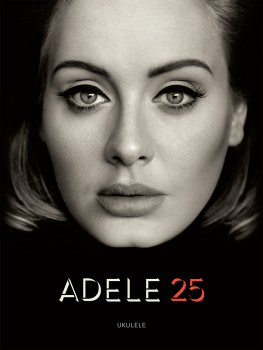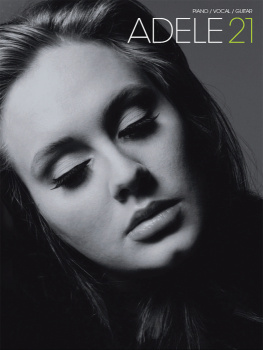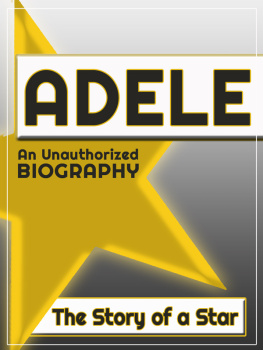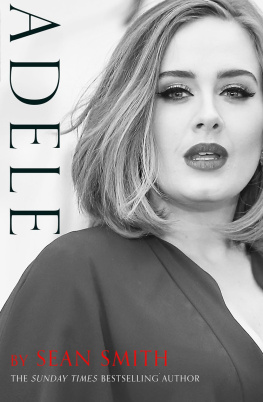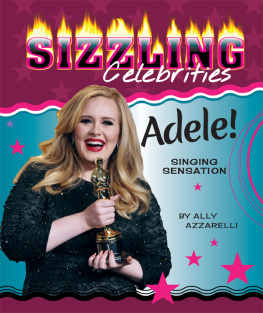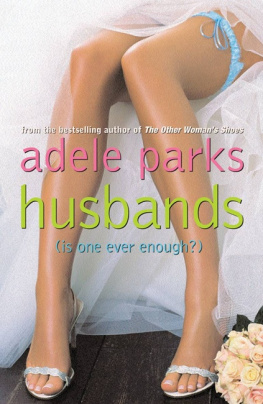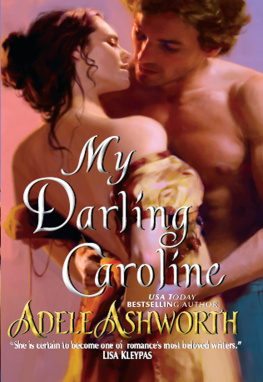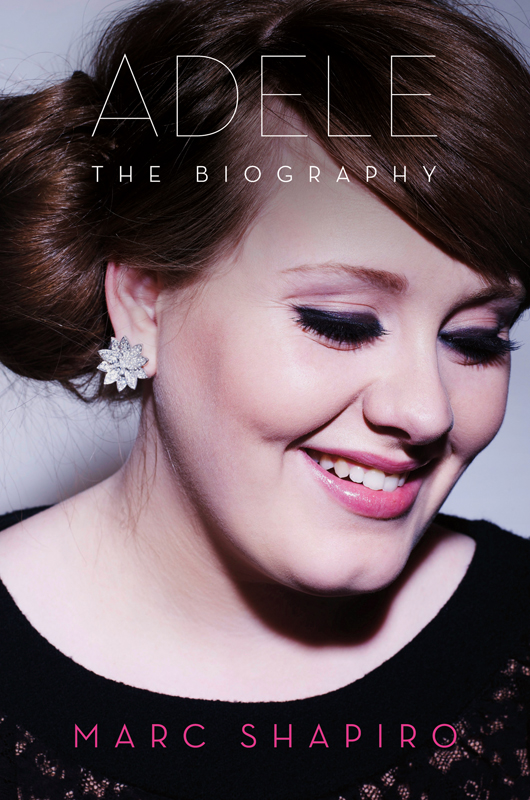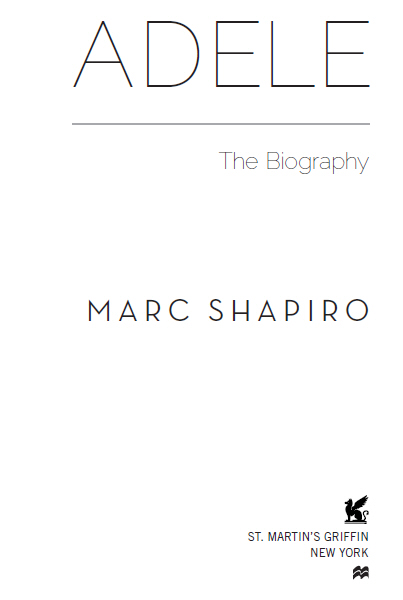
THIS BOOK IS DEDICATED TO
My wife, Nancy. My daughter, Rachael. My granddaughter, Lily. My son-in-law, Ian. Brady and Fitch. Mike. The guy who delivers my newspaper every morning, and all the real people in my life. My agent, Lori Perkins. Marc Resnick at St. Martins. Good books, good art, good music. The fantasy and the reality. The time at the party and the time in solitude. And last but certainly not least thanks, Adele, for a story worth telling.
TABLE OF CONTENTS
INTRODUCTION
THE YEAR THAT WAS
2011 would definitely go down as an eventful year for Adele. And by November, nobody could blame the British-born singer for wanting to pull into her shell for some heavy preholiday rest.
Her debut album, 2008s emotionally wrought exercise in soul, blues, and angst, , and a boatload of rave press notices had labeled this young lass, believably cockney to the core and with a penchant for tales of love as a battlefield, as the next this and the next that .
Comparisons to everybody from Madonna and Amy Winehouse to a modern-day Etta James and all performers in between fell like rain, putting the barely twenty-year-old singer in truly prestigious company and raising the inevitable questions. Questions that, at a time when much of what passed for popular music was cynical, condescending, and worst of all, prefab and devoid of soul, had to be asked.
Could the alternately gregarious and insecure performer with the bright smile, easygoing nature, honest laugh, and potty mouth overcome the dreaded next big thing tag? Would a steady diet of songs bemoaning lost love survive in a world populated by lighter-than-air songs holding momentary space until the next bit of fluff comes along? Could something so simple and to the point work in a world populated by clichs, provocatively dressed performers, and empty, lyrical special effects?
And one more thing: Could Adele, owing more to the past than the present and the future, become the next big thing?
It remained for the January 2011 release of the much-anticipated follow-up, , to cement the idea of Adele as somebody with superstar chops.
was as assured and wide-ranging as its predecessor, mixing and matching her evocative, brilliantly accented vocals and passionate, quite personal songwriting with soul, jazz, pop, hip-hop, and yes, even a heartfelt brand of country influences. Adeles modern telling of universal truths was soothing and to the point. People would admit to falling silent and often tearing up when listening to Adeles music. Those who managed to catch the singer in concert came away from the experience feeling they had discovered a kindred spirit.
Not surprisingly, the power of her music continued to spread like wildfire. The songs Rolling In The Deep, Someone Like You, and Set Fire To The Rain picked up where her previous albums Chasing Pavements and Cold Shoulder left off as mantras for the new introspective generation.
And it was not just the real people who had taken Adele into their hearts. The likes of Kanye West, Beyonc, and Dave Grohl had tweeted her praises and talked her up in interviews. It was not just celebrity BS, the things you say but never mean.
She doesnt carry any of the baggage of todays pop stars, producer Rick Rubin told ABC News . What she makes is her art and at no time does it feel like product.
Shes a voice, and shes classic. I have great admiration for her, said Dolores ORiordan of The Cranberries in an interview in St. Catharines Standard .
Shes got a beautiful voice, Dave Grohl of the Foo Fighters told Digital Spy. People are shocked when they hear actual talent.
People see Adele as someone very real with the potential to be timeless.
Indeed, Adeles songs were certainly not just of the moment. From the spare, tough instrumentals to Adeles haunting, soulful vocal refrains, there is something that defies a sense of the here and now and gone tomorrow. Even the hippest modern technological touches take a backseat to the basics. Once upon a time, when the lights were down low in a smoky club and an audience sat enraptured amid the soft clinking of glasses, this is how music that would last sounded.
At the height of Adeles notoriety, the most jaded of critics hinted at the notion that Adeles songs were standards in the making. Like the great ladies of preceding generationsFitzgerald, Franklin, Holiday, and JamesAdeles sense of stylistic intimacy was the kind of music that would, most assuredly, be played forever. Because there would always be an audience for it. The likes of Rolling In The Deep and Chasing Pavements were songs that listeners would be proud to suggest for the next generation.
s reception and the at-large impact Adeles brand of soul music seemed to be having on her fans and fellow performers alike has always been a concept that she could not completely make sense of. People take some comfort in my songs, she said in a People piece, and thats the most amazing thing.
Over the course of two albums, Adele had turned the idea of lost love and heartbreak into art, something that just made sense to an audience who knew what those emotions were all about, but who had seen many modern artists play fast and loose with those emotions.
The album would sell more than 17 million copies worldwide in the first year and would make Adele the biggest-selling artist of 2011. Sales records fell like so many dominos. She was leaving legends like The Beatles, Madonna, Prince, and Pink Floyd and current fave Lady Gaga in her wake.
It was a dream come true. But then the nightmare kicked in.
Shortly after the albums release, Adele was on a promotional tour of Europe when, during a stopover in Paris, she suddenly lost her voice.
I was right in the middle of singing when, all of a sudden, my voice just popped and it was gone, she said in a 2011 60 Minutes interview. At that point I probably should have stopped singing for at least six months.
But the incident was dismissed as laryngitis and quickly relegated to the price one occasionally pays when youve been singing near nonstop since childhood.
Not so easily dismissed was the blood vessel that burst in her vocal cords during a May concert trip to America. For Adele and her handlers, this was much more serious than laryngitis. Adele returned to London and the injury healed.
There was growing concern, fueled by a serious music press and a not-so-serious tabloid contingent, that at the ripe old age of twenty-three, Adele had possibly done permanent damage to her voice. It seemed like a classic Greek tragedy, done up pop-music style, was in the making.
If Adele was losing sleep over the seemingly growing problem, she was not letting on, preferring instead to bask in the glory of s worldwide success.
Adele attended a best friends wedding in October and did not think twice about honoring the happy couple as only she could. She began to sing
Adele instantly knew something was wrong.
It was later determined that a polyp had formed on her vocal cords and that surgery would be necessarynot the words anybody who lives and dies by their voice wants to hear. At least outwardly, Adele remained calm. She found the best medical minds in the business to diagnose her problem and to suggest a cure. Surgery was performed in early November. The surgery was a success. Whether or not she would ever sing again was still in question.
And how do we know all this? Because in Adeles world, there are no secrets.
Be it her weight, her love life or lack of same, her smoking, her drinking you ask it and Adele will answer it. She has been fond of saying that she loves food and hates exercise. When a French media outlet broke the news that Adele had reportedly made a sex tape, she laughingly denied the allegation and promptly sued for damages. She freely discusses ex-loves but has refused to name them, preferring to relegate them to a much-deserved past that she might only bring up for inspiration. She sometimes drank to excess and has been willing to share the gory details. Dr. Phil would not have to probe too hard to discover Adeles insecurities; she would be only too happy to volunteer them, because the word lie is simply not in her vocabulary.


